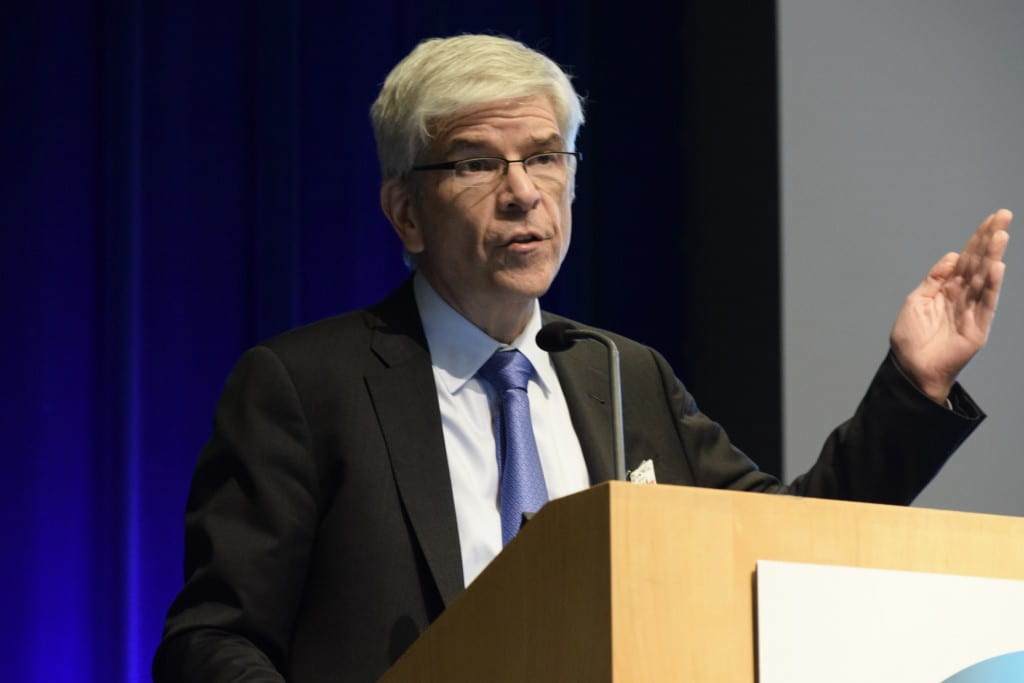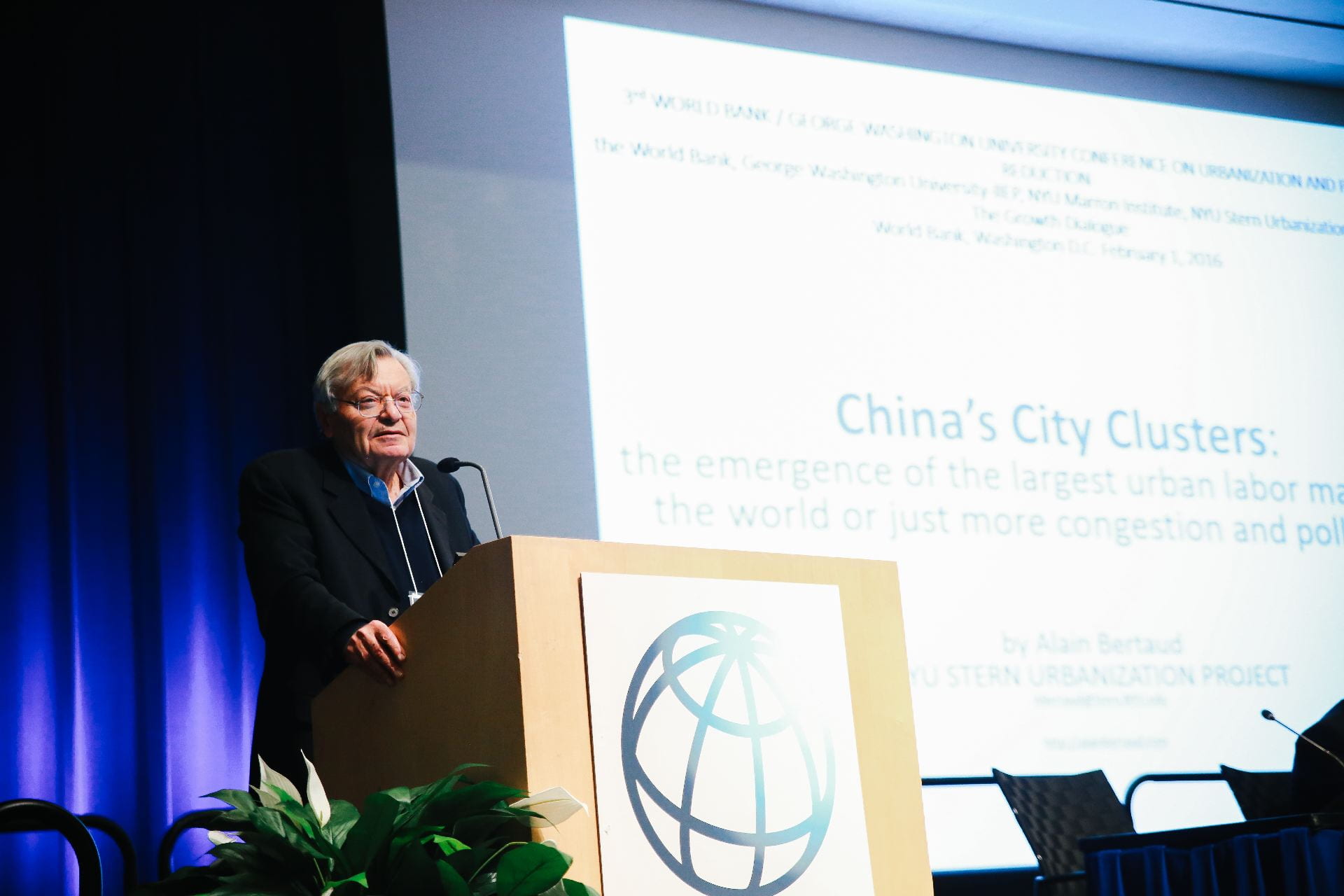Originally published on February 29, 2016
While it is widely understood that urbanization and economic development are closely associated, the expansion of cities gives rise to both opportunities and challenges. Current patterns of urbanization in developing countries highlight the need to provide infrastructure, accompany growth with structural transformation, manage urban spatial expansion, address externalities in congestion and pollution, and establish effective institutions. Now that cities are increasingly vulnerable to climate change risks, the issue of sustainability has reached center stage in urbanization discussions.
Speakers and panelists at the 3rd annual Urbanization and Poverty Reduction Conference explored these challenges and proposed opportunities to improve urban poverty policy at the World Bank on February 1. Sponsored by the Institute for International Economic Policy, the NYU Stern Urbanization Project, the NYU Marron Institute, the Growth Dialogue, and the World Bank, the conference featured speakers ranging from academics to development practitioners who survey sustainability in diverse contexts.
Keynotes
Matthew Kahn of UCLA began the day with a presentation via a recorded PowerPoint, focusing on one of the most pressing themes of the day: the effect of climate change in less-developed countries. He argued that increasing the count of potential migration destinations through the support of local leaders and international aid will allow for cities to facilitate adaptation to climate change and sustainable urban planning. Kahn also called for a global carbon tax to limit the negative impacts of urbanization, combating climate change and the negative impacts felt by the poor.

The first keynote by Jan Brueckner, a Professor of Economics at UC-Irvine, explored how local governments in India and China are relying on land leases to increase state revenue. According to Brueckner, if governments relax the floor-area-ratio in urban buildings, higher land prices and effective urban planning could follow.
Land Efficiency
As more people are living in cities than ever before, the size of urban areas is increasing at an accelerated rate. Shlomo Angel of the NYU Stern Urbanization Project opened the first session with a presentation on managing land efficiency. He proposed that cities, specifically those in sub-Saharan Africa, India, China, and the Middle East, map and measure urban expansion so that they meet sustainability goals such as equity and environmental sustainability.
IIEP affiliate Paul Carrillo expanded on the effects of climate change with evidence from his study of Ecuador. According to Carrillo, higher temperatures in the long-term have negative impacts on income, create nutrient deficiency for mothers, and lower human capital. Essentially, climate change can be a poverty trap for those who do not have climate-adapting technologies.
World Bank economist Ejaz Ghani presented his paper on India’s spatial adjustments and how it affects electricity consumption. Since 1989, India’s geography has undergone interesting changes, including the organized sector’s migration to rural locations, the powerful rise of informal manufacturing within cities, and the development of intermediate cities for manufacturing. However, Ejaz concluded that spatial transformation had not improved energy efficiency and that more insights are needed into the energy usage impact of infrastructure projects.
Klaus Desmet, an economics professor at SMU, concluded session one with an expansion on the geography of development in a global context. Desmet observed that fully liberalizing migration would increase welfare more than three-fold and would significantly affect the evolution of particular regions in the world; however, spatial shocks–such as a rise in sea levels–would contract the effects of liberalized migration.
Urban Development
How might urban development and planning interact with possibilities for economic development? Paul Romer of the NYU Urbanization Project explored this relationship. In developing countries, Romer noted, planning for urban expansion should be the most important priority for both the private and the public sectors – and “the most important priority in economic development.” By maximizing floor space and establishing standards for infrastructure, developing countries can allow for greater growth and mobility in expanding their urban space. Crucially, policy-induced changes in the urban sphere are proven to be more effective than micro-initiatives, according to Romer.

Tufts professor Adam Storeygard presented his and IIEP affiliate Remi Jedwab’s work on how transportation infrastructure coincides with urban development. The paper infers that by 2030, Africa will reach 50% urbanization, but there needs to be far more government intervention in the transportation industry to account for the rise of coups and climate change.
Alain Bertaud of the NYU Urbanization Project discussed the large urban clusters in the eastern cities of China. Today, China faces the challenge of integrating more than 50 million people into the Chinese urban labor market. As a result of inefficient transportation and land development, China’s cluster is larger than anything the world has ever seen. Bertaud suggested that the government invest in an urban highway system that encourages a grid-like structure and more economical transportation – a favorite focus of urban planning.

Negative Externalities of Industrialization
Using evidence from Kanpur, India, Shareen Joshi of Georgetown University assessed the impact of environmental policy on river pollution and infant health. As one might expect, there is tangible evidence for the need of efficient regulation in the developing world.
The costs of environmental destruction began hundreds of years ago, as Walker Hanlon, an economics professor from UCLA, demonstrated in his presentation the costs of the environmental degradation that accompanied the Industrial Revolution. Focusing on pollution from coal burning in the cities of 19th century England, this study brings together new data and a novel analysis strategy in order to estimate the magnitude of the effect of industrial pollution on local economic development from 1851-1911. The results showed that increases in pollution due to local industrial coal use substantially reduced city employment growth and slowed the overall rate of urbanization in England – making a strong case for the reduction of emissions today.
To conclude the final session, Guy Michaels of the London School of Economics examined the effects of floods in urban areas and how they affect migration and economic development. Michaels found an interesting contradiction: low elevation areas are about 3-4 times more likely to be hit by large floods than other areas, and yet they concentrate more economic activity per square kilometer.
Final Roundtable
How can we balance the environmental changes occurring with economic and urban planning? In a final round table discussion focused on sustainable urbanization, Danny Leipziger outlined a plan for a green economy that manages both local and national economic agendas. The major focus for Leipziger was urban planning because in most developing countries, cities and national governments have separate outlooks for development and sustainability, especially in countries (like Vietnam) looking to establish and maintain a middle-income status. By making sustainability the starting point for growing cities, governments – even in states with fewer resources – can potentially close this gap.
However, not everyone agrees that urban planning is the answer to these challenges. Paul Romer, responding from the audience, proposed that the “Portland-style prescriptions about urban planning” could be ineffective in different global contexts. Sumila Gulya responded in support of concepts like inexpensive public transportation and walkable cities, two ideas that could open up the poor to more job opportunities and reduce poverty multidimensionally. Should existing urban areas be improved with this type of planning or should countries lead with urban expansion? Both present challenges to eliminating present and future slum neighborhoods. The issue of overbuilding should also be addressed, since states invest heavily in expansion then struggle to keep citizens from migrating to city centers.
The conference discussions, furthermore, illustrated that poverty is multidimensional. Economic development can occur, but indicators like transportation costs and housing quality must be improved for citizens to likewise improve their quality of life. These indicators have a strong relationship with sustainable urbanization and urban planning, as better public transportation, for example, has positive benefits for both the environment and poverty alleviation.
Despite several external and internal challenges that continue to grip developing countries, there is hope sustainable economies and urbanization are achievable with efficient policy agendas and plans that address the long- and short-term. With sound efforts at both the national and local levels, countries like China, India, and Ecuador as mentioned above, can effectively control urbanization, reduce poverty multidimensionally, and grow sustainably.
